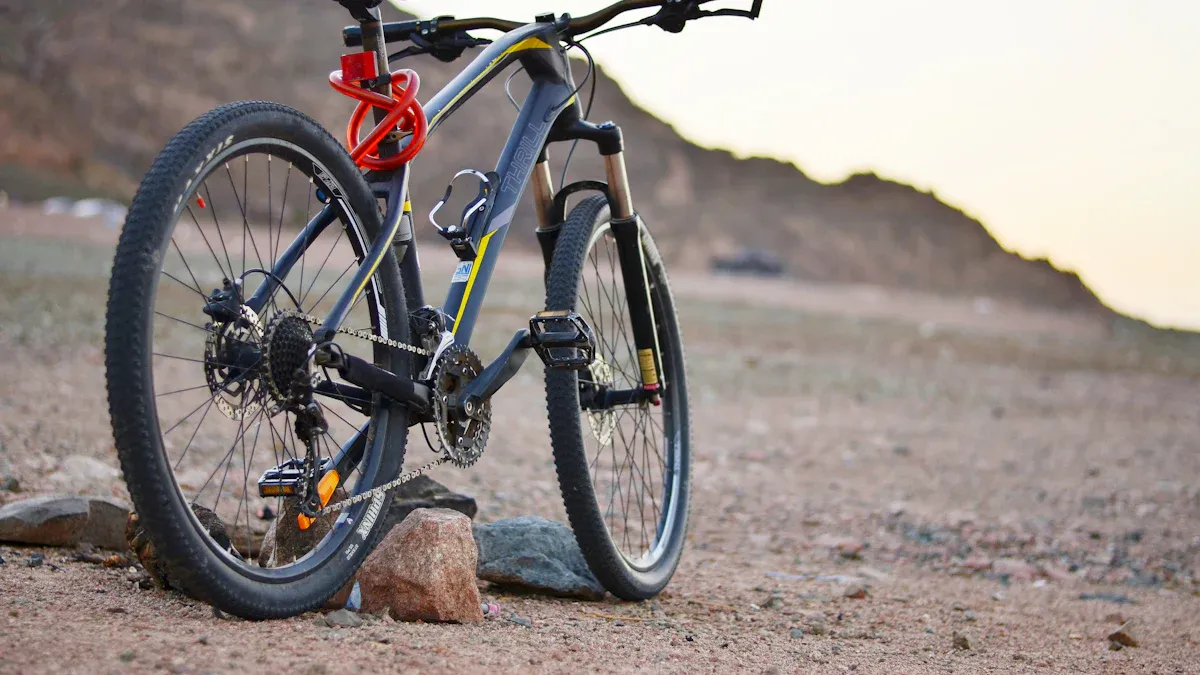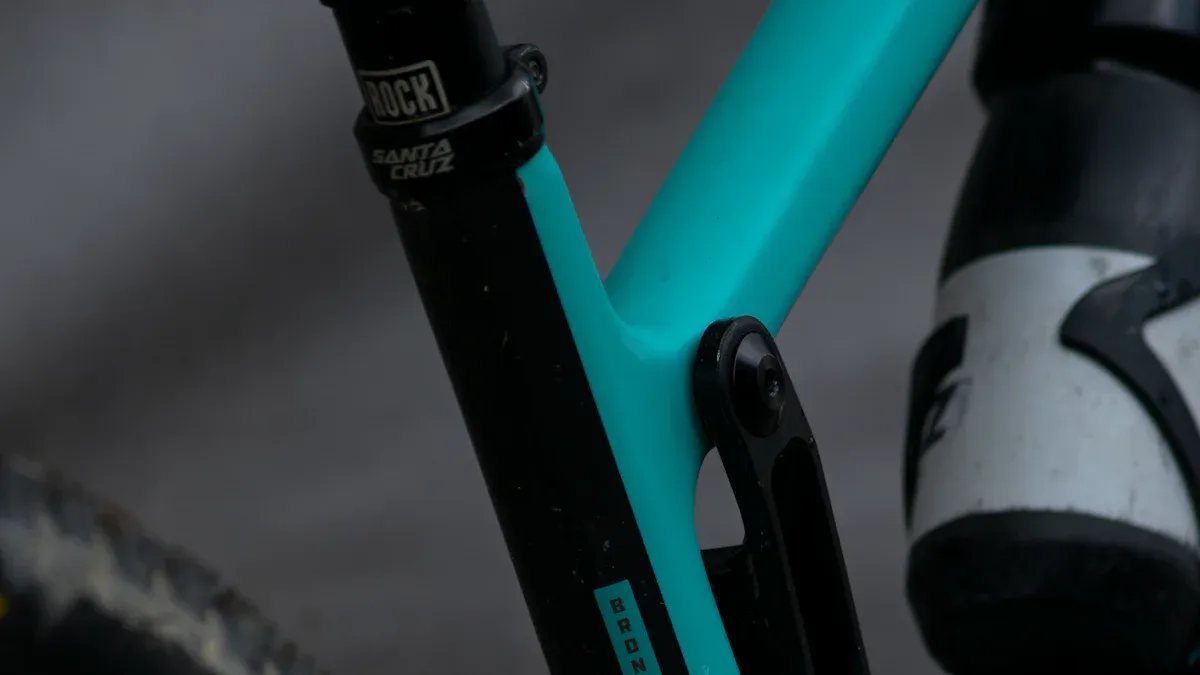
When you buy an alloy frame mountain bike, it can last 5 to 10 years if you take care of it. How long it lasts can change based on a few things. These include how often you ride and how much you weigh. Knowing these things is important. They can affect how strong your bike is. This helps you make smart choices about taking care of it. Keeping your bike in good condition lets you have fun on many trails.
Key Takeaways
Alloy frame mountain bikes usually last 5 to 10 years with proper care and regular use.
Factors like riding frequency, rider weight, weather, and frame design affect how long your bike lasts.
Regular inspections and maintenance, such as checking for cracks and keeping parts clean, help your bike stay strong and safe.
Clean your bike gently with mild soap and store it in a dry place to prevent rust and damage.
Watch for signs like cracks, dents, or strange noises to know when it’s time to repair or replace your bike.
Lifespan of Alloy Frame Bikes

Average Lifespan Range
When you buy an alloy frame mountain bike, it usually lasts 5 to 10 years. How long it lasts depends on different things. These include how often you ride and the conditions you ride in. Riding a lot can cause wear and tear. This can make the bike’s life shorter.
Factors Influencing Durability
Many important factors affect how long your alloy frame mountain bike lasts:
Material Properties: The bike’s durability depends on its material properties. Key parts include:
Fatigue resistance
Corrosion resistance
Strength-to-weight ratio
Manufacturing Techniques: How your bike is made matters a lot. Methods like tube butting and welding quality can make it last longer. For example, TIG welding makes strong joints. Strong joints are important for keeping the bike strong.
Environmental Factors: The weather where you ride is important. Humidity and wetness can cause corrosion. This is especially true if you do not take care of your bike.
Rider Weight and Usage Frequency: Your weight and how often you ride can change the bike’s lifespan. Aluminum alloy frames do not have a fatigue endurance limit. This means that riding a lot can create tiny cracks over time. These cracks happen at stress points like welded joints. Riding often, especially on rough trails, speeds up this fatigue.
Frame Design: The shape of your bike also affects how long it lasts. For example, a steeper head tube angle can make it more responsive. But it may also put more stress on the frame. Here’s a quick look at how frame shape affects durability:
Frame Geometry Aspect | Role in Durability and Handling |
|---|---|
Head Tube Angle | Affects steering response and stability; a steeper angle gives more responsiveness. |
Chainstay Length | Changes handling; shorter chainstays help acceleration, while longer ones improve stability. |
Seat Angle | Affects climbing efficiency; a steeper angle helps climbing, while a shallower angle makes descents more comfortable. |
Knowing these factors helps you make smart choices about riding and maintenance. Taking good care of your alloy frame mountain bike can help it last longer. This way, you can enjoy many adventures on the trails.
Maintenance for Alloy Frame Mountain Bikes

Taking care of your alloy frame mountain bike is very important. It helps your bike last longer and keeps you safe while riding. Checking your bike regularly and cleaning it well can really help it stay strong.
Regular Inspections
You need to check your bike often to find problems early. Here’s a simple list to help you:
Visual Damage Check: Look for cracks, dents, or wear on the frame and parts.
Brake and Gear Adjustments: Make sure brakes work well and gears shift easily. This keeps you safe when riding.
Tire Pressure: Check tire air before each ride. Good tire pressure helps performance and lowers flat risks.
Bolt Tightness: Check that important bolts, like axles and pivots, are tight. Use the right torque to avoid overtightening.
If you ride a lot, aim for basic checks every week. For less frequent riding, monthly checks are good. Also, think about getting a professional service every 6 months to 1 year for complex parts and safety.
Inspection Interval | Inspection Type | Details and Recommendations |
|---|---|---|
Basic Checks | Check brake pads, fork air pressure, and lubricate the chain to keep safe and perform well. | |
Every 3 to 6 months | Critical Parts Inspection | Check drivetrain parts (chain, cassette, derailleur), tires, and hydraulic brake fluid condition. |
Every 6 months to 1 year | Professional Servicing | Get rear shock service and frame service from professionals to fix wear, damage, and complex tasks. |
Cleaning and Storage Tips
Cleaning your alloy frame mountain bike is key to stopping rust and keeping it looking good. Here are some good cleaning tips:
Use mild soap and soft brushes to clean your bike. Don’t use strong degreasers that can harm the alloy frame.
Rinse off mud and dirt right after rides. This helps stop rust, especially from road salt.
Dry your bike gently to keep its finish. Rubbing too hard can dull the frame’s coating.
Lubricate the chain and moving parts with mountain bike oils for smooth operation.
For storage, keep these tips in mind:
Store your bike in a dry, safe place. Don’t leave it outside, as moisture can cause rust.
Use breathable covers if you want to keep dust off your bike. Non-breathable covers can trap moisture and speed up rust.
Make sure there is good air flow around your bike to stop condensation.
By following these maintenance tips, you can keep your alloy frame mountain bike in great shape for many years. Regular care not only improves performance but also keeps you safe on the trails.
Signs for Replacement of Alloy Frame Bikes
Knowing when to replace your alloy frame mountain bike is very important for your safety and how well it works. Here are some signs to look for:
Structural Damage Indicators
You should check your bike often for signs of damage. Look for:
Cracks: Inspect the frame, especially near welds. Cracks can grow slowly but may cause sudden breaks.
Dents: Big dents can weaken the frame’s strength.
Corrosion: Watch for rust or pitting, especially if you ride in wet areas or near saltwater. Corrosion can make the frame weaker and lead to serious problems.
If you see any of these issues, think about getting help from a professional. Some damage can be fixed, but aluminum frames often need special skills for repairs.
Performance Decline Signs
While riding, pay attention to changes in how your bike performs. Common signs of problems include:
Creaking or Groaning Noises: These sounds can mean cracks are forming. Unlike steel frames, aluminum frames show wear before they break completely.
Reduced Responsiveness: If your bike feels less stable or responsive, it might mean the frame is getting weak.
Increased Vibration: If you feel more vibrations while riding, it could mean the frame has lost its strength.
Aluminum alloy mountain bike frames can become brittle over time from bending and flexing. They do not have a clear fatigue limit, so they can break after many stress cycles. If you notice any of these performance issues, it might be time to think about replacing your bike.
Ignoring these signs can be dangerous. Structural cracks can cause falls or accidents, especially while riding. Always put your safety and your bike’s condition first.
Reason for Replacement | Explanation |
|---|---|
Aluminum frames build up tiny cracks over time, which can weaken them and cause failure. | |
Reduced Frame Strength and Stiffness | Cracks from fatigue make the frame weaker, making it less safe and reliable. |
Frame Failure Risk | Repeated stress can make aluminum frames break sooner, leading to the need for replacement. |
By keeping an eye out for these signs, you can make sure your riding stays safe and fun.
In short, your alloy frame mountain bike can last 5 to 10 years if you take care of it. Regular maintenance is very important for making it last longer. You need to check your bike, clean it, and store it properly. Look for signs of damage or problems with how it rides. Spotting these signs early helps you know when to get a new bike. By following these tips, you can have many fun years of riding.
FAQ
What is the best way to clean my alloy frame mountain bike?
Use mild soap and a soft brush to clean your bike. Rinse off dirt immediately after rides. Avoid strong degreasers that can damage the alloy frame.
How often should I inspect my bike?
Inspect your bike at least once a month. If you ride frequently, check it weekly. Regular inspections help catch issues early and ensure safety.
Can I repair a cracked alloy frame?
Repairing a cracked alloy frame is challenging. It often requires professional skills. If you notice cracks, consult a bike mechanic for advice on repair or replacement.
What should I do if my bike feels less responsive?
If your bike feels less responsive, check for structural damage. Look for cracks or dents. If you find any, consider getting a professional assessment.
How can I store my bike to prevent damage?
Store your bike in a dry, cool place. Avoid leaving it outside. Use breathable covers to keep dust off while allowing airflow to prevent rust.
See Also
Advantages And Disadvantages Of Aluminum Bike Frame Strength
Comparing Enduro Bike Frame Materials For Durability And Power
Reasons Steel Mountain Bike Frames May Be Right Or Wrong
Key Factors To Evaluate When Selecting An E-Mountain Frame
Performance And Durability Insights On Chinese Carbon Bike Frames
